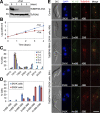Proximity Interactions among Basal Body Components in Trypanosoma brucei Identify Novel Regulators of Basal Body Biogenesis and Inheritance
- PMID: 28049148
- PMCID: PMC5210500
- DOI: 10.1128/mBio.02120-16
Proximity Interactions among Basal Body Components in Trypanosoma brucei Identify Novel Regulators of Basal Body Biogenesis and Inheritance
Abstract
The basal body shares similar architecture with centrioles in animals and is involved in nucleating flagellar axonemal microtubules in flagellated eukaryotes. The early-branching Trypanosoma brucei possesses a motile flagellum nucleated from the basal body that consists of a mature basal body and an adjacent pro-basal body. Little is known about the basal body proteome and its roles in basal body biogenesis and flagellar axoneme assembly in T. brucei Here, we report the identification of 14 conserved centriole/basal body protein homologs and 25 trypanosome-specific basal body proteins. These proteins localize to distinct subdomains of the basal body, and several of them form a ring-like structure surrounding the basal body barrel. Functional characterization of representative basal body proteins revealed distinct roles in basal body duplication/separation and flagellar axoneme assembly. Overall, this work identified novel proteins required for basal body duplication and separation and uncovered new functions of conserved basal body proteins in basal body duplication and separation, highlighting an unusual mechanism of basal body biogenesis and inheritance in this early divergent eukaryote.
Importance: The basal body in the early-branching protozoan Trypanosoma brucei nucleates flagellum assembly and also regulates organelle segregation, cell morphogenesis, and cell division. However, the molecular composition and the assembly process of the basal body remain poorly understood. Here, we identify 14 conserved basal body proteins and 25 trypanosome-specific basal body proteins via bioinformatics, localization-based screening, and proximity-dependent biotin identification. We further localized these proteins to distinct subdomains of the basal body by using fluorescence microscopy and superresolution microscopy, discovered novel regulators of basal body duplication and separation, and uncovered new functions of conserved basal body proteins in basal body duplication and separation. This work lays the foundation for dissecting the mechanisms underlying basal body biogenesis and inheritance in T. brucei.
Copyright © 2017 Dang et al.
Figures







Similar articles
-
Regulated protein stabilization underpins the functional interplay among basal body components in Trypanosoma brucei.J Biol Chem. 2020 Jan 17;295(3):729-742. doi: 10.1074/jbc.RA119.011352. Epub 2019 Dec 9. J Biol Chem. 2020. PMID: 31819011 Free PMC article.
-
The Centriole Cartwheel Protein SAS-6 in Trypanosoma brucei Is Required for Probasal Body Biogenesis and Flagellum Assembly.Eukaryot Cell. 2015 Sep;14(9):898-907. doi: 10.1128/EC.00083-15. Epub 2015 Jun 26. Eukaryot Cell. 2015. PMID: 26116214 Free PMC article.
-
A Spef1-interacting microtubule quartet protein in Trypanosoma brucei promotes flagellar inheritance by regulating basal body segregation.J Biol Chem. 2022 Jul;298(7):102125. doi: 10.1016/j.jbc.2022.102125. Epub 2022 Jun 10. J Biol Chem. 2022. PMID: 35697071 Free PMC article.
-
Basal body structure and cell cycle-dependent biogenesis in Trypanosoma brucei.Cilia. 2016 Feb 8;5:5. doi: 10.1186/s13630-016-0023-7. eCollection 2015. Cilia. 2016. PMID: 26862392 Free PMC article. Review.
-
Assembly of the flagellum and its role in cell morphogenesis in Trypanosoma brucei.Curr Opin Microbiol. 2010 Aug;13(4):453-8. doi: 10.1016/j.mib.2010.05.006. Epub 2010 Jun 10. Curr Opin Microbiol. 2010. PMID: 20541452 Review.
Cited by
-
Subcellular Transcriptomics and Proteomics: A Comparative Methods Review.Mol Cell Proteomics. 2022 Feb;21(2):100186. doi: 10.1016/j.mcpro.2021.100186. Epub 2021 Dec 16. Mol Cell Proteomics. 2022. PMID: 34922010 Free PMC article. Review.
-
Discovery of effectors for casein kinase signaling in the African trypanosome.Sci Rep. 2025 Jul 2;15(1):23284. doi: 10.1038/s41598-025-05668-9. Sci Rep. 2025. PMID: 40604009 Free PMC article.
-
ZapE/Afg1 interacts with Oxa1 and its depletion causes a multifaceted phenotype.PLoS One. 2020 Jun 24;15(6):e0234918. doi: 10.1371/journal.pone.0234918. eCollection 2020. PLoS One. 2020. PMID: 32579605 Free PMC article.
-
APEX2 Proximity Proteomics Resolves Flagellum Subdomains and Identifies Flagellum Tip-Specific Proteins in Trypanosoma brucei.mSphere. 2021 Feb 10;6(1):e01090-20. doi: 10.1128/mSphere.01090-20. mSphere. 2021. PMID: 33568455 Free PMC article.
-
Centriole and transition zone structures in photoreceptor cilia revealed by cryo-electron tomography.Life Sci Alliance. 2024 Jan 5;7(3):e202302409. doi: 10.26508/lsa.202302409. Print 2024 Mar. Life Sci Alliance. 2024. PMID: 38182160 Free PMC article.
References
Publication types
MeSH terms
Substances
Grants and funding
LinkOut - more resources
Full Text Sources
Other Literature Sources
Molecular Biology Databases

